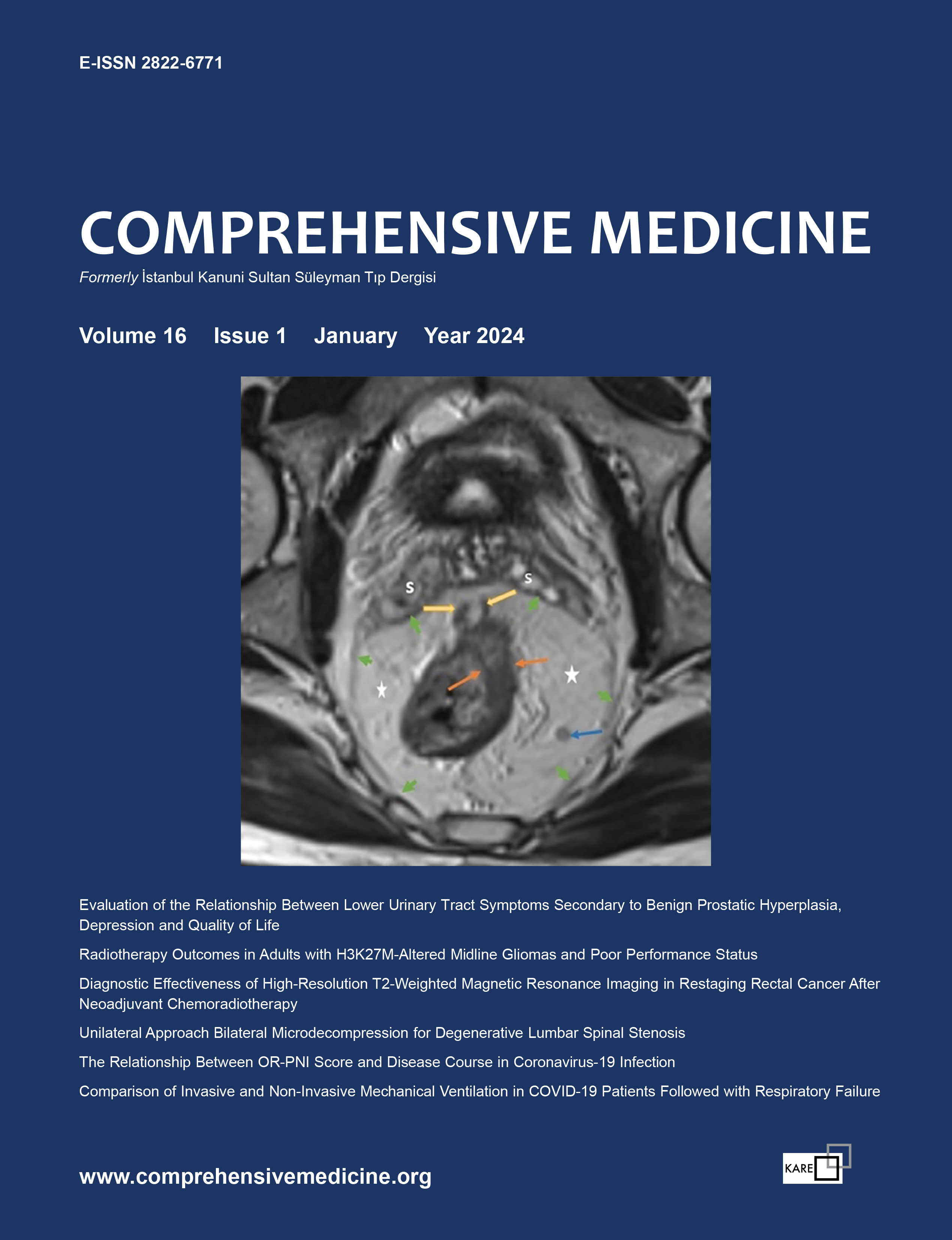






The Effects of Type of Delivery on Pelvic Floor and Bladder Neck
İbrahim Polat, Naile Gökçe Akagündüz, Gonca Yıldırım, Volkan Ülker, Vuslat Lale Bakır, Ali Ekiz, Ali İsmet TekirdağIstanbul Kanuni Sultan Suleyman Research And Training Hospital, Obstetric And Gynecology DepartmentOBJECTIVE: To investigate the effect of methods of delivery on pelvic relaxation which is thought to lead to urethral mobility, stress urinary incontinence and development of cystocele.
METHODS: 225 primigravid patients who gave birth in Bakirkoy Gynecology-Obstetrics and Pediatric Research and Training Hospital between June 2011 and September 2011 were involved in the study. Each patient was evaluated during their 35-36 gestation weeks. The patients were re-examined in the 12th postpartum week. The cystocele was assessed. A stress test and Q test (by using a specially designed type of protractor) were performed to those with a history of stress incontinence. Patients with a vaginal delivery (n=155), and with C-section deliveries in the active (n=36) and in the latent phase (n=34) of labor constituted the study groups.
RESULTS: Birth weight was significantly lower in vaginal delivery group. SUI (stress urinary ıncontinence) was present in 19 (12.3 %) patients in the vaginal delivery and in 4 (5.7 %) patients in C-section group. No significant difference was found between the groups. The rates of cystocele was significantly different between the groups. The rate of cystocele was higher in the vaginal delivery group compared to the active phase C-section group. In addition, it was higher in the active phase C-section group than in the latent phase C-section group. In the Q tip test, ≥36 degree descensus was found in 26 (16.8 %) patients in the vaginal delivery and in 4 (5.7 %) patients in C-section groups. The difference was statistically significant. Cases with 2. and 3. degree, and also phase 2 and phase 3 cystoceles were present in vaginal delivery group while only phase 1 cystocele patients were present in latent phase C-section group. A positive correlation was present between the rates of stress incontinence, cystocele, a Q-test positivity, birth weight and duration of 2nd stage of labor.
CONCLUSION: The study results showed that the vaginal delivery is a serious risk factor for pelvic floor relaxation compared to C-section, while C-section performed in the active phase of labor constitutes higher risk than elective C-section and is not completely protective against pelvic relaxation.
Doğum Şeklinin, Pelvik Taban ve Mesane Boynu Üzerinde Etkileri
İbrahim Polat, Naile Gökçe Akagündüz, Gonca Yıldırım, Volkan Ülker, Vuslat Lale Bakır, Ali Ekiz, Ali İsmet TekirdağS.b. İstanbul Kanuni Sultan Süleyman Eğitim Ve Araştırma Hastanesi, Kadın Hastalıkları Ve Doğum KliniğiAMAÇ: Doğum şeklinin pelvik relaksasyon oluşumuna ve buna bağlı olarak ortaya çıktığı düşünülen üretra mobilitesi, stres üriner inkontinans ve sistosel oluşumuna etkisini araştırmak.
YÖNTEMLER: Ocak 2011-Mayıs 2011 tarihleri arasında Bakırköy Kadın Doğum ve Çocuk Hastalıkları Eğitim Araştırma Hastanesinde doğum yapan 225 primigravid hasta çalışmaya alındı. Her biri gebeliğinin 35-36.haftasında değerlendirildi. Çalışmada yer alan hastalar postpartum 12. haftada tekrar muayene edildi. Sistosel değerlendirildi, stres inkontinans tarifleyenlere stres test yapıldı, özel olarak yapılmış bir açı ölçerle Q tip test yapıldı. Vajinal doğum yapan 155 hasta, aktif fazda sezaryen olan 36 hasta ve latent fazda sezaryen olan 34 hasta ile çalışma gruplarımız oluştu.
BULGULAR: Bebek doğum ağırlığı vajinal doğum grubunda anlamlı olarak daha düşüktü. Vajinal doğum grubunda SÜİ saptanan 19 (% 12.3) olgu ve sezaryen grubunda SÜİ saptanan 4 (% 5.7) olgu vardı. Bu iki grup arasında istatistiksel olarak anlamlı düzeyde fark saptanmadı (p=0.207). Sistosel pozitiflik oranları arasında anlamlı fark saptandı (p<0.001). Vajinal doğum grubundaki sistosel pozitiflik oranının aktif fazda sezaryen grubundan yüksek olduğu bulundu (p=0.023). Ayrıca, aktif fazda sezaryen grubundaki sistosel pozitifliği oranı latent faza sezaryen grubundan yüksekti (p=0.027). Vajinal doğum grubunda Q testi ≥36 derece olan 26 (% 16.8) olgu, sezaryen grubunda Q testi ≥36 derece olan 4 (% 5.7) olgu vardı.İstatistiksel olarak anlamlı fark vardı. (p=0.041). Vajinal doğum yapanlarda 2 ve 3. derece olgular vardı, yine bu grupta evre 2 ve 3 sistosel olan olgular da varken latent faz grubunun tamamı evre 1 sistoseldi. Stres inkontinans sıklığı, sistosel sıklığı ve Q tipi test pozitifliğinin her biri, birbirleriyle ve bebek doğum ağırlığı, doğumun 2. evresinin süresiyle pozitif ilişkili bulundu.
SONUÇ: Vajinal doğumun pelvik taban relaksasyonu için sezaryen doğuma göre daha ciddi bir risk faktörü olduğu, doğumun aktif fazında yapılan sezaryenın da elektif sezaryena göre daha riskli olup tamamen koruyucu olmadığı sonucuna varıldı.
Corresponding Author: İbrahim Polat, Türkiye
Manuscript Language: Turkish








